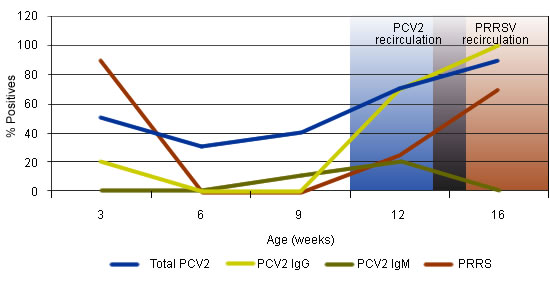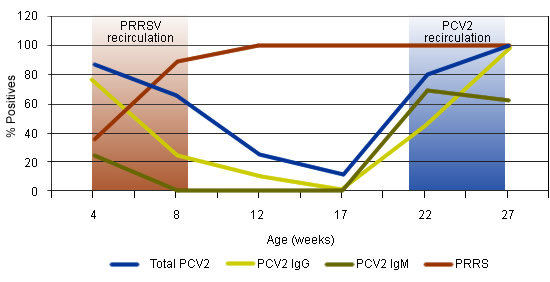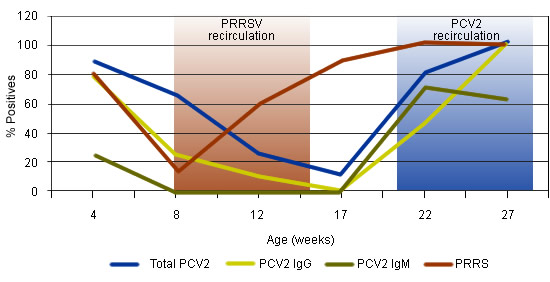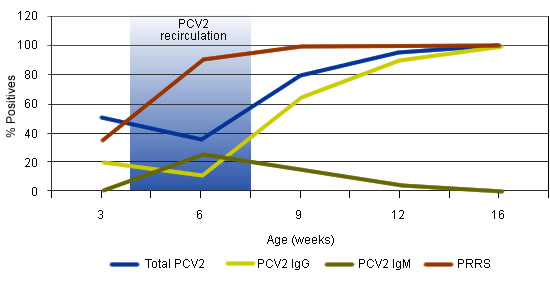– Health.A pertinent, viable system would be one that is able to maintain a balance between these factors.
– Handling.
– Facilities.
– Feeding.
– Genetics.
– Welfare.
– The cost of all of these.
There are many diverse causes of imbalance; time changes, breakdowns, vacation…But, of all the possibilities, the biggest cause of imbalance is illness.
And among illnesses, apart from those which are obligatory to report, the most influential ones are probable: PRRS and those associated with PCV2. A combination of the two is particularly disastrous for swine production.
Why are these diseases so problematic?
– They are immuno-suppressive.There is much room for discussion when it comes to the efficiency of the PRRS vaccine. As far as the vaccines against PCV2, there is practically no room for debate, they are all a very effective.
– They are viral; therefore antibiotics cannot be used to control them. Prevention is fundamental to control, and an important tool for this is vaccines.
Just because the PCV2 vaccines are effective doesn’t mean that problems cannot arise due to their use. The most common problems are due to:
– Interference with maternal antibodies.These problems can be associated more with the application of the vaccine than with the vaccine itself.
– Coincidence of vaccination with a recirculation of PRRS: viremic animals.
When is the right time to vaccinate?
– At a time when maternal immunity is not overly elevated.On a farm where PRRS and PCV2 is recirculating, there are four distinct possibilities.
– At least 15 days before the recirculation of the virus.
– At a time when all the animals are healthy. It’s particularly important that PRRS does not recirculate.
Case 1:
Late recirculation of PRRS and PCV2.
When faced with this situation, there are 3 distinct options:
• Vaccinate piglets against PCV2 starting at 3 weeks. In the case of elevated maternal immunity, delaying vaccination until 5 or 6 weeks is recommended.
• Vaccinate breeding sows.
• Vaccinate piglets and breeding sows. In this case the piglets should be vaccinated when they are at least 6 weeks old since vaccinated sows produce colostrum that is very rich in defences.
Case 2:
Late recirculation of PCV2 and early recirculation of PRRS
Options:
• Delay the PCV2 vaccine for piglets to avoid the recirculation of PRRS.Regardless of the option chosen, it is necessary to take measures to try and control the recirculation of PRRS.
• Vaccinate breeding sows.
• Vaccinate piglets and breeding sows.
Case 3:
Late recirculation of PCV2 and recirculation of PRRS during weaning.
Options:
• Step up the PCV2 vaccination of piglets. This is only feasible if maternal immunity is not overly elevated. Also, measures need to be taken in order to control the recirculation of PRRS.
• Vaccinate breeding sows.
• The option of vaccinating piglets and breeding sows doesn’t make much sense here, since their vaccination should be delayed a long while, firstly to save the maternal antibodies and secondly to avoid the recirculation of PRRS.
Case 4:
Early recirculation of PCV2.
Options:
• When faced with this situation, the only option is to vaccinate the breeding sows against PCV2 to try and delay recirculation among the piglets.It is important to keep in mind that a farm is a “living structure” where any one of these situations can evolve into another, making it necessary to adapt the vaccination situation to the new situation. The objective is to maintain the farm in optimal conditions.
Of the four cases, without a doubt the most favourable is the first, in this situation it is easier to maintain the balance and there are more options for the correct application of the vaccine.




